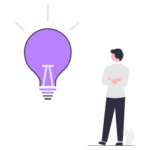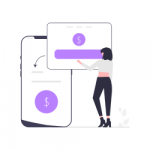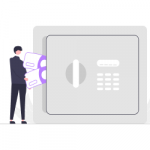Reinventing your career in the stay-at-home world may seem like a crazy idea, but for some people this was just the perfect time to make that change. At our recent event, Arcelia De La Rosa, a CX Associate, shared her very recent experience of making a career transition, talked about what it means to be a newcomer in CX, and provided tips for anyone who wants to switch to CX. Intrigued? Read on to learn her story or watch the video of our interview with Arcelia at the end of the article.
Contents
The interview
Arcelia, please tell us a bit about yourself.
I am a first-generation Mexican. I have worked in education management and youth development. I had the chance to live and work in Morocco for about six years. Then I moved back to Texas when I gave birth to a little person. This time gave me an opportunity to learn about a lot of different things. It's kind of why I'm in the place where I am right now.
What is your background and what was your previous career?
I've always worked in customer service. I worked with my parents, who had a manufacturing company, and I was one-on-one with customers. As I furthered in my career, I became and enjoyed being a professor.
“When you are working as a professor, you are still dealing with customers except they're your students. Сustomer service is something that's always been ingrained in me.”
My last job was in the service industry. I worked in a restaurant, and I had to balance my life and work. My job as a server wasn't so much about the financial goals that I could achieve. My job was more about making somebody's experience that tremendous. I was always thinking about what's going to make my service and their experience stand out? What's going to make it different?
“It's the interaction that you have with your server. It's going to be the interaction you have with your manager. So that became my priority. And it still is.”
What's your current position and responsibilities?
I am a Customer Experience Associate for a company called Snappy, which is a gift-giving business. We work with HR departments to help them with their employment appreciation programs. It's nice to have everything that I've been working for during the past several months come to fruition. I feel like I'm very privileged because I have some great mentors in CX and customer experience that have helped me learn many of the skills that I'm taking forward.
Even within the first week of being there, I already saw opportunities of "we can do this because of this". I had a chance to discuss my ideas with the director, and she heard me and liked them. I will get to learn even more about how to help scale a CX department.
Why did you decide to switch to CX?
Previously, I had no idea of what CX and Customer Success Management (CSM) were. I have an amazing best friend from high school that I've known for almost 25 years, who works in the tech industry. He sat me down one day and just, as a best friend should do, metaphorically slapped me across the head and said: "You have this skill set. You can do this. You need to get into CX and CSM." His recognition of what I can do inspired me to move forward.
When switching to a new career, what was relevant from your previous experience and job roles?
My previous jobs helped me with doing project management. Working in the service industry, working at the International Youth Foundation, working with stakeholders, and retaining partnerships implied the same things you would do in CX and CSM. You have to find the person. You have to entertain them. What do I need to do to ensure they're happy? What can I do to make their journey easier?
So, for example, I aligned IYF’s soft-skills curriculum product with the Texas State Board of Education curriculum so they (the schools within the program) could reach their KPIs. And all these things were things that you take forward when you go to CSM again. It's just learning the vocabulary for CX and CSM and how what you did before parallels into your new career.
And when it comes to working as an English as a Foreign Language teacher, you have students that constantly have different journeys.
"You have a journey map in your head. You just don't realize it."
When I talk about the company that I worked for, the International Youth Foundation, I didn't realize that we did journey mapping with potential stakeholders. We did the concept of journey mapping and putting things together, and getting the information. I have just never realized it until now.
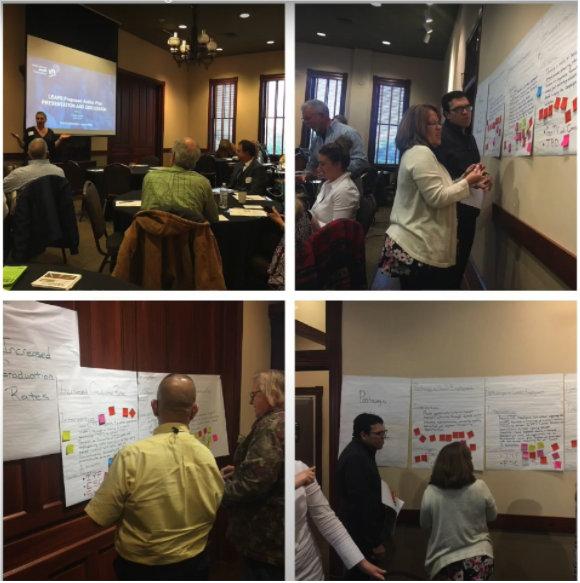
What were the first steps that you took at the beginning of your transition?
The first thing that I did was I took an online course at Udemy. It was a very simple class on the basics of CSM. When I was taking it, all I could think of was: "Oh, I've done this (in my prior careers)!" And, I also thought that it had prepared me fully for my career transition. (I was incredibly wrong!)
Then I went to Gainsight’s online conference, Pulse Anywhere, on CSM or CX that I had found on LinkedIn. And I crashed it. I just kept pestering people with the questions until somebody paid attention to me.
"It was always the same question on my transitioning: what should I do? I realized I don't know as much as I thought. I started taking notes, and I have one whole page for vocabulary that I have to reference."
Those were my first steps, and that's how I keep going forward with this.
What was the easiest part of your transition?
This is a wonderful challenge that you have to put in front of you. You have to tie yourself to a "mast decision." You say you're going to do it. And you're going to put all of your energy going that way. The easiest part was listening to somebody who recognized what I had to offer and go forward with that.
What's the most challenging part of the transition?
The most challenging part is not giving up. You get overwhelmed. When it comes to CSM, there's no centralized person or company that says "this is it." The sphere is constantly evolving. The words are not always the same. The vocabulary is not still the same. So, you have to cross-reference it and see what this means. Then figuring out what kind of CSM person you're going to be, what kind of CX person you're going to be.
“The hardest part is understanding because there's no unison from what I can see when it comes to CX and CSM. Even when you have mentors, they're using different terminology.”
What is your current experience with personas and journey mapping?
When you're studying, you hear about different kinds of personas. I wasn't planning to do one until one of my mentors said that I needed to create a persona. It would showcase what I did beforehand and show me that I was really on the right path, and my skills were transferable. And he said that I could also put it on my digital portfolio.
The first time I created a persona, I did it of a literal student that I previously had. When Keith, my mentor, looked at it, he was like: "Good… But”. You don't want to hear those words from a mentor. You just want to hear something like "You knocked it out of the park!"
So we revised it. It finally clicked when he told me to create a Frankenstein persona of my students.
"I know that you can use resources from the Internet. You can use different articles. Or, you can use yourself. I was the resource because I had worked for five years in Morocco as an English teacher."
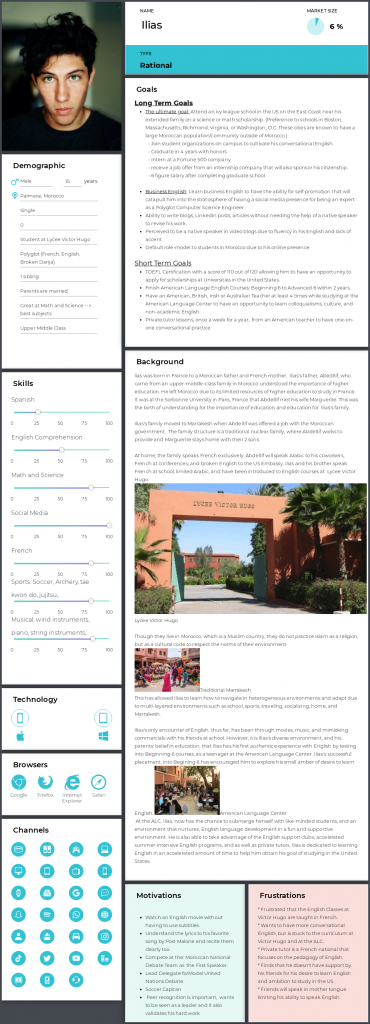
I ended up with the bad boy that I posted on LinkedIn.
My next step is to build a journey map associated with my persona in UXPressia.
What are the benefits of having mentors?
I have a "mentor squad". And, I think everybody should have mentors. I'm blessed that I have four people. I have a gentleman that works for a very big company. He gives me the Latinx perspective, which is important as I am a Latinx woman.
I was really lucky to meet Nate Brown who's one of the top CX success leaders. He's the one who introduced me to the world of CX just by reading my question. When I crashed the Wix CX conference, he read my question to the discussion panel. Nate is the reason that I had the opportunity to meet Keith and Carlos, as well as other people within the CX community.
I reached out to Nate, and he put me on the CX Accelerator Slack Channel. It was there that I met Keith Kmett. He helps me a lot with my persona and creating visuals for everything. I have a mentor named Patrick Richards, who works for the Predictive Index. I reached out to him, and he has shown me a lot more of the data. Patrick is the reason that I started to understand more the importance of data in the world of CX.
Right now, I have a wonderful woman named Jessica as a mentor. That's important to me because she's a CX director. She has tattoos like I do, and she's Latinx, those things resonate. They are all very different and have very specific CX tools and teachings that they help me with.
There are different conversations with every person. Having all that funneled into me allows me to become productive. It allows me to share my story. It allows me to believe in myself! Because anytime I have self-doubt, a mentor of mine, who's been into CX for 15 years or 20 years, says: "No, you're doing the right thing."
"I would recommend mentors and not to fear approaching somebody. The worst they can say is "No."
I don't believe I would have been able to get this far, this fast in my journey, had it not been for their support. And I have so much more to go. It just feels encouraging knowing that I have my CX and CSM squad.
What would be your advice to those who decided to transition to CX/UX?
I think one important thing is not to sell yourself short. I would do that every once in a while until my friends or people around me would say: "No, don't sell yourself short! You have worked hard. You have worked feverously, and that passion will take you to the next level.”
“Don't apologize for asking for help. Don't apologize for not knowing something. Don't apologize for just being yourself in needing help.”
You also need hard skills. Learn a CRM, learn Salesforce, learn a ticket-based platform if you want to do CX. There are tutorials. There are Udemy courses. There are LinkedIn courses.
It is also good to add yourself to the mailing list for CSMs, client success, or CX.
Find your tribe and slowly branch out from that. So for me, my tribe is Latinx and tech. Some Latinx people that work in the tech industry are very supportive. I'm on their Slack channels. Find Slack channels that you can do.
Is there any advice for those who are looking for their first job in the industry?
Update your LinkedIn profile, make that bad boy shine. I did a resume building with one of the classes that I found on Udemy. It took me two months to update my resume and my LinkedIn page. But, because I have - it is how I landed the job that I have now. It is because it is that good.
Don't get frustrated if you don't get callbacks. Networking helps you get your resume higher up, make sure your resume is ATS-compliant, so it's picked up correctly through the resume readers.
Don't be shy of contract positions. If that's where you start and can shine, then shine on. Stary by having the opportunity to put your foot in somewhere. When you get frustrated and overwhelmed, turn to your team, turn around, and just be honest with them so that they can support you because you're going to need it every once in a while.
The video
Watch the recording below to see the full interview with Arcelia about her transitioning to CX and listen to her answers at the Q&A session, where we had many great questions.
